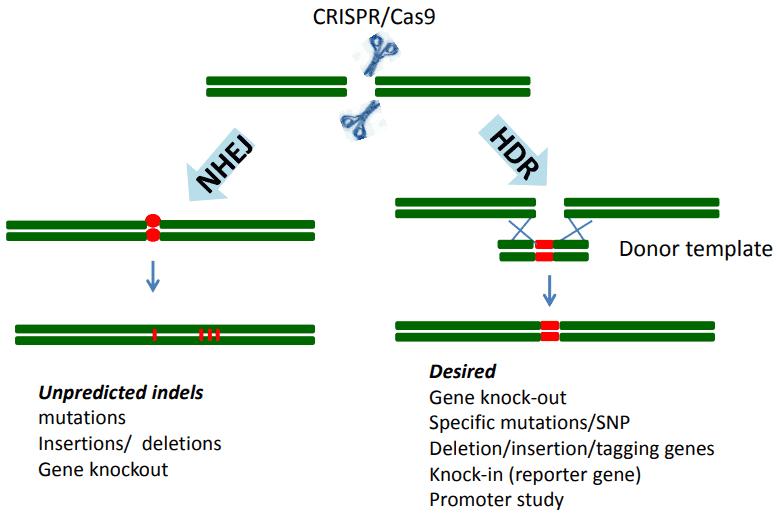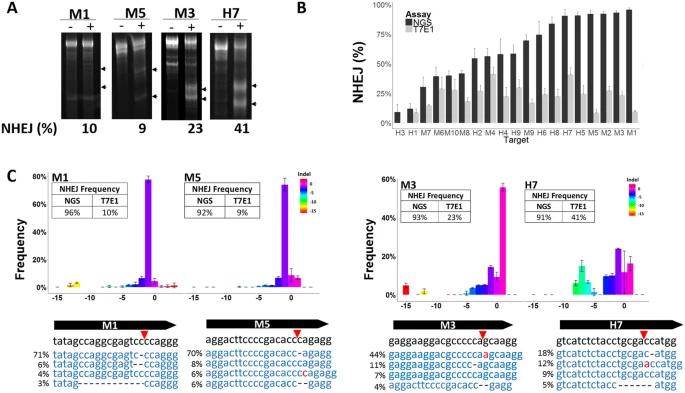What is CRISPR/Cas9 Technology
CRISPR/Cas9 technology is one of the most popular methods used for genome editing by introducing both Cas9 endonuclease and a guide RNA into the cells of interest. The guide RNA is designed to direct the Cas9 endonuclease to a particular site in the genome where it produces a double-strand break (DSB). There are generally two ways to repair the double-stranded break: non-homologous end-joining (NHEJ) or homologous directed repair (HDR). NHEJ is the main form of repair in mammalian cells. As it is error-prone, repair via the NHEJ pathway allows for insertion, deletion, loss-of-function mutations which probably result in frameshifts and affect protein expression. In addition to knockout mutations, a template DNA can be introduced to direct HDR and create mutations in the gene-of-interest. HDR faithfully copies the template sequence to the cut target site.
 Figure 1. Genome editing by CRISPR/Cas9 technology is achieved via repair.
Figure 1. Genome editing by CRISPR/Cas9 technology is achieved via repair.
How to Use NGS for Genome Editing Validation
Although the CRISPR system is efficient for genome editing. However, some cells in a population will not be edited, some will have one allele edited, and some will have both alleles edited. It is important to validate genome edits after CRISPR/Cas9 experiments. Next generation sequencing (NGS), as a powerful and high-throughput approach, can be utilized for screening of CRISPR-induced mutations. NGS can simultaneously look at off-target changes in a large number of samples. When using this method, it is necessary to keep a set of control cells. Software such as CRISPResso can be used for data analysis. NGS is also suited for assessing genome edits created by ZFN (Zinc-finger nuclease) or TALEN (Transcription activator-like effector nuclease).
Sentmanat et al. (2018) described the NGS approach for genome edits validation in his published work. Briefly, CRISPR sequencing involves a two-step PCR protocol and deep sequencing. First, the target genomic site of interest is amplified with a primer that contains partial Illumina sequencing adaptors. Next, a second PCR with primers containing indices and necessary Illumina sequencing adaptors. As a result, the target regions will be amplified. The qualified PCR products are then subjected to deep sequencing with the Illumina MiSeq platform.
NGS techniques for validation encompass several key approaches:
Whole-Genome Sequencing (WGS) stands out as a comprehensive method for discerning CRISPR/Cas9-induced genomic changes. By sequencing the entire genome, WGS offers unparalleled coverage to identify insertions, deletions, and other alterations. This technique is instrumental in assessing the effectiveness of CRISPR/Cas9 editing, while also uncovering rare mutations within the genome.
Targeted Amplicon Sequencing, on the other hand, zooms in on specific genomic regions, including CRISPR/Cas9 target sites and neighboring areas. With its high depth of coverage, this technique excels at detecting minutiae mutations, serving as a valuable tool to corroborate the precision of CRISPR/Cas9 alterations. Particularly beneficial for assessing edits in individual genes or a limited set of targets.
Off-Target Analysis is pivotal in predicting and sequencing potential off-target sites generated by CRISPR/Cas9 modifications. This method aids in evaluating the specificity and safety of CRISPR/Cas9 edits by identifying unintended alterations. It plays a crucial role in assessing the accuracy and safety profiles of CRISPR/Cas9 editing methodologies.
Long-Range PCR and Sequencing take a complementary approach by amplifying large genomic regions surrounding CRISPR/Cas9 target sites before sequencing. This method is adept at capturing structural variations and chromosomal rearrangements stemming from CRISPR/Cas9 manipulations. It proves to be a valuable tool in detecting substantial genomic changes induced by CRISPR/Cas9 editing procedures.
 Figure 2. CRISRP-Cas9 activity reported with the T7E1 Assay and Next-Generation Sequencing. (Sentmanat et al., 2018)
Figure 2. CRISRP-Cas9 activity reported with the T7E1 Assay and Next-Generation Sequencing. (Sentmanat et al., 2018)
How are Off-Target Mutations Detected
Another limitation of CRISPR technology is the occurrence of Off-target cuts. The CRISPR system cuts not just at its target place, but also at unintended sites with similar sequences. These off-target cuts may produce undesirable and even harmful mutations. Over the past few years, scientists have established several NGS-based approaches to detect off-target mutations.
Table 1. NGS-based approaches to detect off-target mutations.
| Assays |
Description |
Resources |
| In vitro genome-wide assays |
| Digenome-Seq |
Genomic DNA is first digested with a nuclease and then subjected to whole genome sequencing. Off-targets can be computationally identified. |
Kim et al. 2015
Web tool: http://www.rgenome.net/digenome-js/#!
Code: https://github.com/chizksh/digenome-toolkit2 |
| SITE-Seq |
Genomic DNA is cleaved using Cas9 nuclease, and Cas9 nuclease cleavage sites are biochemically tagged and enriched. High-throughput sequencing and bioinformatics analysis is then used to detect off-target cleavage sites. |
Cameron et al. 2017
Protocol: Protocol Exchange, doi:10.1038/protex.2017.043 |
| Cell-based genome-wide assays |
| LAM-HTGTS |
Chromosomal translocations of off-target and on-target breaks are PCR amplified and analyzed by NGS. |
Frock et al. 2015
Protocol: Nat Protoc, 11:853-71, 2016
Code:http://robinmeyers.github.io/transloc_pipeline/index.html |
| BLISS |
DSBs are biochemically labeled, and their downstream sequences are PCR amplified and analyzed using NGS. |
Yan et al. 2017 |
References:
- Yan W X, Mirzazadeh R, Garnerone S, et al. BLISS is a versatile and quantitative method for genome-wide profiling of DNA double-strand breaks. Nature communications, 2017, 8: 15058.
- Sentmanat M F, Peters S T, Florian C P, et al. A survey of validation strategies for CRISPR-Cas9 editing. Scientific reports, 2018, 8(1): 888.
- Frock R L, Hu J, Meyers R M, et al. Genome-wide detection of DNA double-stranded breaks induced by engineered nucleases. Nature biotechnology, 2015, 33(2): 179.
- Cameron P, Fuller C K, Donohoue P D, et al. Mapping the genomic landscape of CRISPR–Cas9 cleavage. Nature methods, 2017, 14(6): 600.
- Kim D, Bae S, Park J, et al. Digenome-seq: genome-wide profiling of CRISPR-Cas9 off-target effects in human cells. Nat Methods, 12:237-43, 2015.
- https://www.the-scientist.com/lab-tools/new-methods-to-detect-crispr-off-target-mutations-30013


 Sample Submission Guidelines
Sample Submission Guidelines
 Figure 1. Genome editing by CRISPR/Cas9 technology is achieved via repair.
Figure 1. Genome editing by CRISPR/Cas9 technology is achieved via repair. Figure 2. CRISRP-Cas9 activity reported with the T7E1 Assay and Next-Generation Sequencing. (Sentmanat et al., 2018)
Figure 2. CRISRP-Cas9 activity reported with the T7E1 Assay and Next-Generation Sequencing. (Sentmanat et al., 2018)